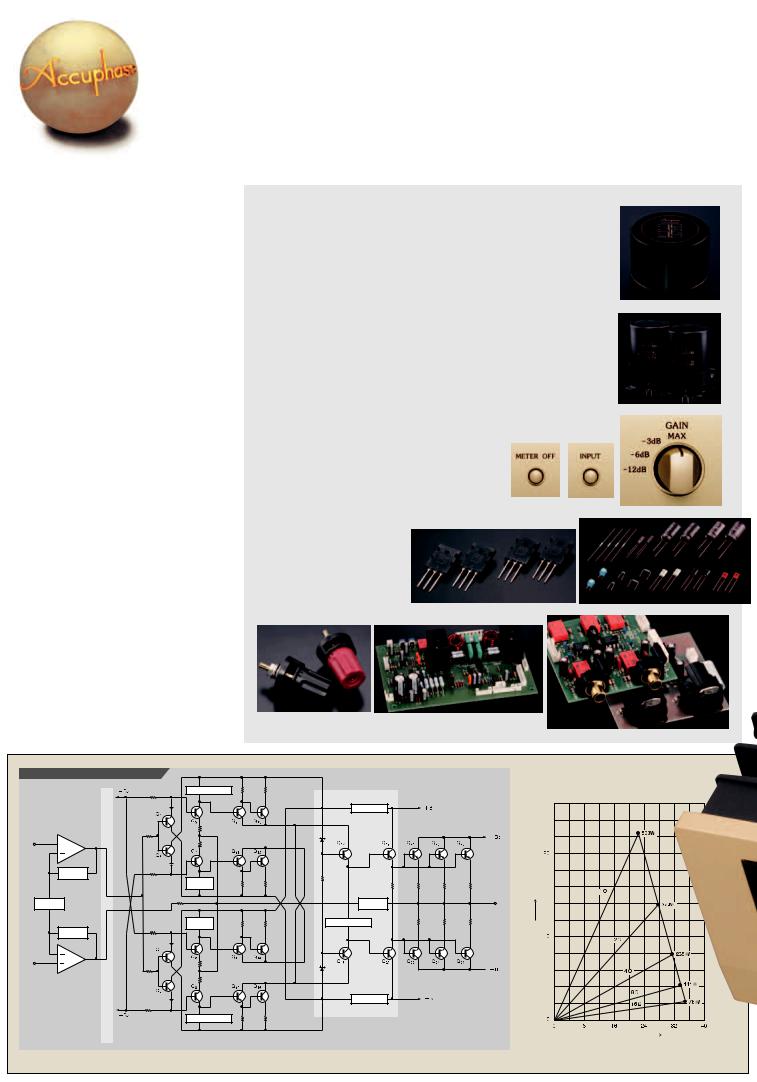Accuphase P-4100 Brochure

m Output stage with 3-parallel push-pull configuration for each channel delivers high power and handles very low impedance loads m Instrumentation amplifier principle used for signal paths m Further refined MCS+ circuit topology m Current feedback circuit combines excellent sound quality with total operation stability m Bridged connection mode allows upgrading to monophonic amplifier m Massive toroidal transformer rated for 950 VA m 4-step gain control

Stereo power amplifier capable of delivering 500 watts into 1 ohm (music signal) – Instrumentation amplifier principle allows fully balanced signal paths. Further refined MCS+ and current feedback topology assure outstanding S/N ratio, minimum distortion, and excellent performance in all other aspects, resulting in superb sound quality. 3-parallel push-pull arrangement of highpower transistors in each channel, sustained by power supply with massive 950 VA toroidal transformer. 4-step gain control minimizes residual noise.
The P-4100 is a stereo power amplifier that takes sophisticated sound to the next level. While inheriting design technology from highly renowned Accuphase models such as the P-7100 and M-6000, the new model features instrumentation amplifier topology and a refined MCS+ circuit to lower the noise floor even further. Only specially selected top-grade materials and parts are used throughout with impressive results.
In order to bring out the full potential of the loudspeakers, an amplifier must be able to cope with drastically fluctuating speaker impedance conditions. This can only be achieved by ensuring constant drive voltage at all times. In other words, the output impedance of the amplifier must be kept very low. This also makes it possible to absorb the counterelectromotive force generated by the voice coil, thereby eliminating a major source of intermodulation distortion.
The P-4100 achieves these design goals with ease. The output stage for each channel uses three pairs of high-power transistors with a Pc rating of 220 watts, arranged in a parallel push-pull configuration. This ensures low output impedance. Stable operation is achieved by mounting the devices to massive heat sinks on both sides of the chassis, for efficient dissipation of thermal energy. As demonstrated by the power rating of 500 watts into 1 ohm (with music signals), the P-4100 can easily drive speakers with very low impedance, and speakers with uneven impedance curves are handled with complete authority. Using the P-4100 in bridged mode creates a mono amplifier with even more impressive power capability. The power supply section which acts as energy source for the amplifier employs a massive 950 VA toroidal transformer in combination with large filtering capacitors, providing ample reserves even with drastically fluctuating loads.
The overall configuration of the P-4100 employs the latest instrumentation amplifier principle, allowing fully balanced signal paths throughout. In addition, the power amplifier section features refined MCS+ topology in combination with current feedback, for further enhanced electrical performance characteristics.
nPower modules with high-power transistors in 3-parallel push-pull arrangement deliver 500 watts per channel into 1 ohm (music signals only), 360 watts into 2 ohms, 180 watts into 4 ohms, or 90 watts into 8 ohms.
nAmply dimensioned power supply with high-efficiency toroidal transformer and large filtering capacity.
The high-efficiency toroidal transformer is rated for approx. 950 VA, and the two extra-large 47,000μF aluminum electrolytic capacitors were selected for best sonic performance.
nBridged mode allows upgrading to monophonic amplifier with 1,000 watts into 2 ohms (music signals only), 720 watts into 4 ohms, or 360 watts into 8 ohms.
Bridged connection increases the output by a factor of 4, creating dramatic power reserves in a monophonic configuration.
nFour gain control settings minimize residual noise.
The gain control alters gain in the first stage of the instrumentation amplifier. Four settings are available (MAX, –3 dB, – 6 dB, –12 dB).
Toroidal power transformer
Filtering capacitors
n Large analog power meters with on/off switch. n Mode selector for easy switching between dual
mono/stereo/bridged operation. |
Meter on/off button Input selector |
n Fully balanced input stage |
Gain selector |
|
|
shuts out external noise |
|
interference. |
|
nTwo pairs of oversize speaker terminals accept also Y lugs plugs.
High-power transistors used in output stage |
Parts selected for sound quality and reliability |
Large speaker terminals |
Assembly with meter and protection circuitry |
Assembly with unbalanced and balanced input connectors
Instrumentation amplifier
Bias stabilizer circuit |
* 1-ohm operation possible with music signals only |
|
|
|
REGULATOR |
|
|
+ INPUT |
|
|
|
|
NFB |
|
|
|
|
NETWORK |
Bias stabilizer |
|
|
|
|
|
|
||
|
circuit |
|
|
|
GAIN CONTROL |
|
NFB |
|
|
CIRCUIT |
|
NETWORK |
OUTPUT |
|
|
|
|
||
|
Bias stabilizer |
Bias stabilizer circuit |
(A) |
|
NFB |
circuit |
|||
|
||||
|
|
|
||
NETWORK |
|
|
current |
|
|
|
|
||
– INPUT |
|
|
Output |
|
|
|
|
||
|
|
REGULATOR |
|
|
|
Bias stabilizer circuit |
|
|
|
|
High-power transistors |
Output voltage (V) |
|
|
Gain control |
MCS+ (Multiple Circuit Summing) |
in 3-parallel push-pull configuration |
Figure 2 Load impedance vs. output power |
||
|
Figure 1 Circuit diagram of amplifier section (one channel) |
||||
|
(output voltage/output current) |
||||
